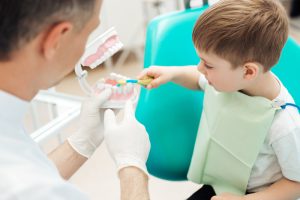Oral Health Diseases in Children
Cavities: Avoid Them This Year!
January 5, 2019Sugar Addiction and Children
January 18, 2019
When you think of common diseases in the U.S., you probably don’t think of cavities. However, cavities are actually considered a disease, and they go by the term of “tooth decay”. This disease is incredibly common in children and people of all age groups. Children have a higher risk for oral health diseases because of diet, oral hygiene and several other factors. Not only are they susceptible to tooth decay, but they can easily be affected by other oral health diseases at a young age. Use these tips to help your child avoid oral health diseases!
Cavities
One of the most common worries that parents have with children and oral health is that of cavities. Cavities, also known as tooth decay or caries, are permanently damaged areas in the hard surface of your teeth that form tiny openings or holes. They can be caused by a number of things, but primarily they occur due to not cleaning your teeth well, frequent snacking, drinking lots of sugary drinks, and bacteria in your mouth. Cavities are one of the most common health problems globally, but children and teenagers are most susceptible to them. Even infants can get cavities! When left untreated, they can get larger and affect even the deepest layers of your teeth. Many symptoms include severe toothaches, pain when eating/drinking something hot or cold, visible holes in your teeth, brown staining on teeth, and tooth sensitivity.
Additionally, some children are more susceptible to cavities than others. While everyone is at risk for developing cavities, there are some factors that have an increased risk:
- Not getting enough fluoride
- Tooth location (most tooth decay occurs in your back teeth)
- Inadequate brushing
- Bedtime infant feeding
Fluoride is a mineral that strengthens teeth and helps them become more resistant to decay. Making sure that children are drinking fluoridated water or brushing each day with fluoride-fortified toothpaste is important for protection against cavities and developing strong teeth. For the first two years of life, parents should brush their children’s teeth until the age of 3. At this age, children begin brushing their own teeth, but parents should make sure to re-brush those areas on their child’s teeth that are hard to clean until the age of 6. Parents should continue to supervise their children’s brushing schedule until the age of 9 when most children are capable of completing thorough cleanings. When babies are given bottles filled with milk or juice at night, these beverages stick to young children’s teeth all night, which allows for tooth decaying bacteria to grow. This is called baby bottle tooth decay, and can also occur with toddlers as they wander around drinking juice from their sippy cups.
Children and Oral Health

Cavities aren’t the only oral health problems that children can experience. Without proper preventative care, children, even with their baby teeth, can experience enamel wear, tooth decay, and gum disease. For young children, implementing good food choices is one goal that each parent should have. Foods with high sugar content and eating a large consumption of sugar each day contribute to tooth decay in children. According to the American Heart Association, adult men should only consume up to 38 grams of sugar per day, and adult women should have up to 25 grams per day. Children should consume no more than 6 teaspoons (24 grams) of sugar per day, and children younger than 2 are advised not to have any.
Dental sealants are another route to go when creating your oral health plan. Dental sealants protect the narrow grooves of your teeth from plaque accumulation, and thus help prevent cavities and other tooth decay. Many times, teeth have small pits or grooves that food particles get stuck in, which causes cavities. Dental sealants help seal those holes and prevent bacteria from getting in. More than 68% of children ages 6-9 did not receive sealants on their first molars, and more than 86% of children ages 10-14 did not receive sealants on their second molars. This simple procedure can prevent future oral problems by allowing plaque to easily brush off each day and maintain healthy teeth.
Don’t Forget Dental Visits
Parents play an integral role in protecting their children’s teeth. They establish a routine for their children, and show by example the importance of oral hygiene. Helping your child establish healthy dental hygiene early on can help lay the foundation for strong, healthy teeth in the future. By establishing a “dental home,” children are more likely to seek and receive optimal oral health care and develop healthy oral habits that will continue on into adulthood. Planning for and taking children to their dental visits every six months is a great way to start your child’s oral health on the right foot. A child’s first dental appointment should begin within six months after their very first tooth appears, and no later than their first birthday. By taking your child to the dentist every six months, your dentist can better monitor your child’s teeth and prevent tooth decay before it even starts.
We see pediatric patients with cavities and other tooth decay issues that can be preventable. Regular visits with a dentist can ensure that your child receives the quality care and attention that their mouth needs. You can set your child up for oral health success by scheduling them a dental appointment with Hardy Pediatric Dentistry & Orthodontics today at (720) 887-6003!